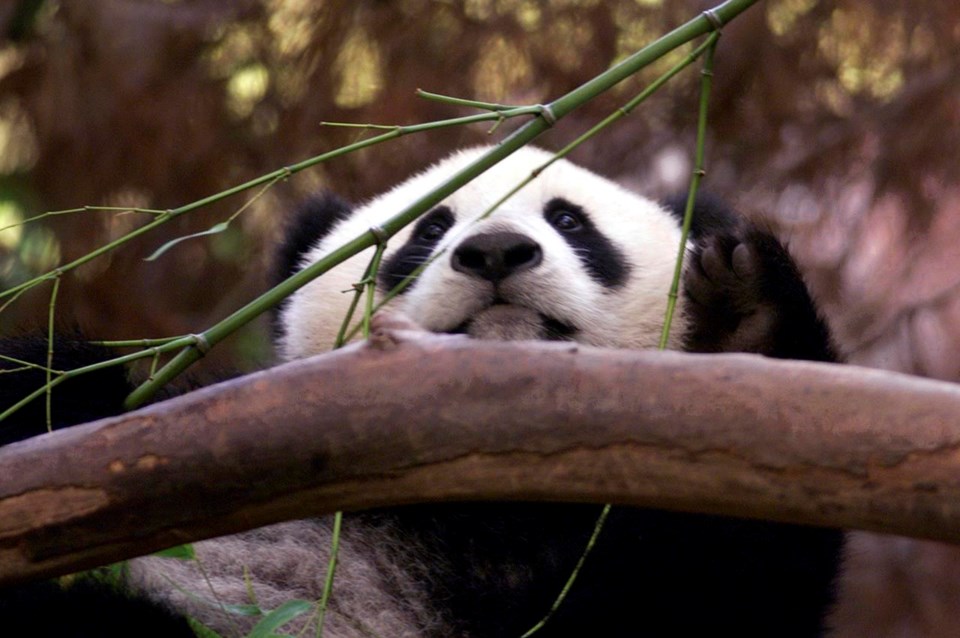SAN DIEGO (AP) — China for the first time in more than two decades is sending pandas to the United States to the delight of the San Diego Zoo, which is preparing to receive a pair that could include a female descendent of Bai Yun and Gao Gao, two of the zoo's former residents that were among the most reproductively successful panda mates in captivity.
The China Wildlife Conservation Association said Thursday it also signed agreements with the zoo in the Spanish capital of Madrid, and is in talks with zoos in Washington, D.C., and Vienna, quelling fears that Beijing was ending its historic panda diplomacy with Western nations due to diplomatic tensions.
“We look forward to further expanding the research outcomes on the conservation of endangered species such as giant pandas, and promoting mutual understanding and friendship among peoples through the new round of international cooperation,” Chinese Foreign Ministry spokesperson Mao Ning said in Beijing.
The partnership will include research on disease prevention and habitat protection and contribute to China’s national panda park construction, the organization said.
The black-and-white bears have long been the symbol of the U.S.-China friendship since Beijing gifted a pair of pandas to the National Zoo in Washington, D.C., in 1972, ahead of the normalization of bilateral relations. China later loaned pandas to zoos to help breed cubs and boost the population.
But only four giant pandas remain in the United States, all at the zoo in Atlanta, after China did not renew loan agreements at three other zoos in San Diego, Washington, D.C., and Memphis, Tennessee, in recent years.
Cindy Rose has been coming to the San Diego Zoo for 40 years and would go see Bai Yun before she and the bear’s son, her sixth cub, were sent back to China in 2019. They had been the zoo’s last pandas.
“I’m so excited!” she said. “We love the pandas, and it’s so great one will be related to the one that was here.”
She and her husband, Randy Rose, brought their grandson to the zoo on Thursday.
“It makes me feel good that this is one way to reduce tensions,” Randy Rose said. “We have a lot of differences but we all love pandas. They’re fun to watch, munching on bamboo and climbing trees.”
San Diego Zoo officials told The Associated Press that if all permits and other requirements are approved, the two bears, a male and a female, are expected to arrive by the end of summer.
“We’re very excited and hopeful,” said Megan Owen of the San Diego Zoo Wildlife Alliance and vice president of Wildlife Conservation Science. “They’ve expressed a tremendous amount of enthusiasm to re-initiate panda cooperation starting with the San Diego Zoo.”
In November, Chinese President Xi Jinping raised hopes his country would start sending pandas to the U.S. again after he and President Joe Biden convened in Northern California for their first face-to-face meeting in a year and pledged to try to reduce tensions. Speaking at a dinner with business leaders on the sidelines of the Asia-Pacific Economic Cooperation summit in San Francisco, Xi called the bears “envoys of friendship" and said he learned the San Diego Zoo and people in California “very much look forward to welcoming pandas back.”
Bai Yun, who was born in captivity in China, lived at the zoo for more than 20 years and gave birth to six cubs there. Her mate Gao Gao was born in the wild in China and lived at the San Diego Zoo from 2003 to 2018 before being sent back.
Decades of conservation efforts in the wild and study in captivity saved the giant panda species from extinction, increasing its population from fewer than 1,000 at one time to more than 1,800 in the wild and in captivity.
Zoos typically pay a fee of $1 million a year for two pandas, with the money earmarked for China’s conservation efforts, according to a 2022 report by America’s Congressional Research Service. The pandas return to China when they reach old age and any cubs born are sent to China around age 3 or 4.
The life expectancy of a giant panda in the wild is about 15 years, but in captivity they have lived to be as old as 38.
The U.S., Spain and Austria were among the first countries to work with China on panda conservation, and 28 pandas have been born in those countries, China's official Xinhua News Agency said.
Demands for the return of giant pandas, known as China’s “national treasure,” had grown among the Chinese public as unproven allegations that U.S. zoos mistreated the pandas flooded Chinese social media.
The San Diego Zoo continued to work with their Chinese counterparts even after it no longer had any pandas.
Owen of the San Diego Zoo said China is particularly interested in exchanging information on the zoo's successful breeding of pandas in captivity. Giant pandas are difficult to breed in part because the female’s reproductive window is extremely narrow, lasting only 48 to 72 hours each year.
Bai Yun's first cub, Hua Mei, was the first panda born through artificial insemination to survive into adulthood outside of China, and would go on to produce 12 cubs on her own after she was sent to China.
Bai Yun, meanwhile, remained at the zoo, where she gave birth to two more females and three males. With cameras in her den, researchers monitored her, contributing to the understanding of maternal care behavior, Owen said.
“We have a lot of institutional knowledge and capacity from our last cooperative agreement, which we will be able to parlay into this next chapter, as well as training the next generation of panda conservationists,” she said.
___
Associated Press writer Ken Moritsugu in Beijing contributed to this report.
Julie Watson, The Associated Press




